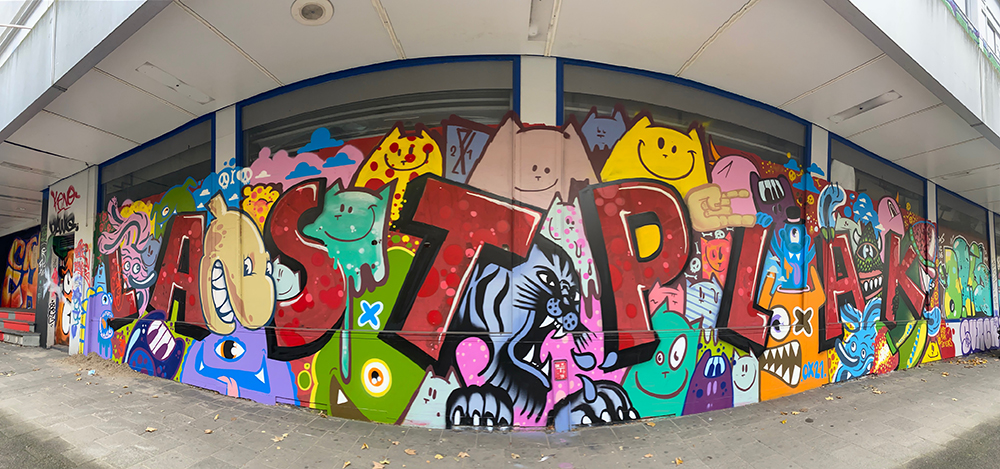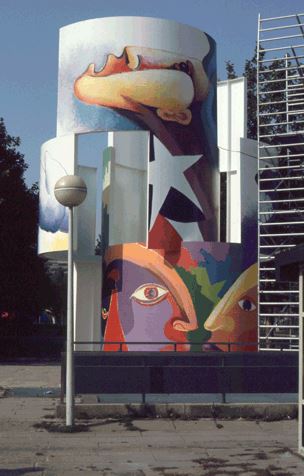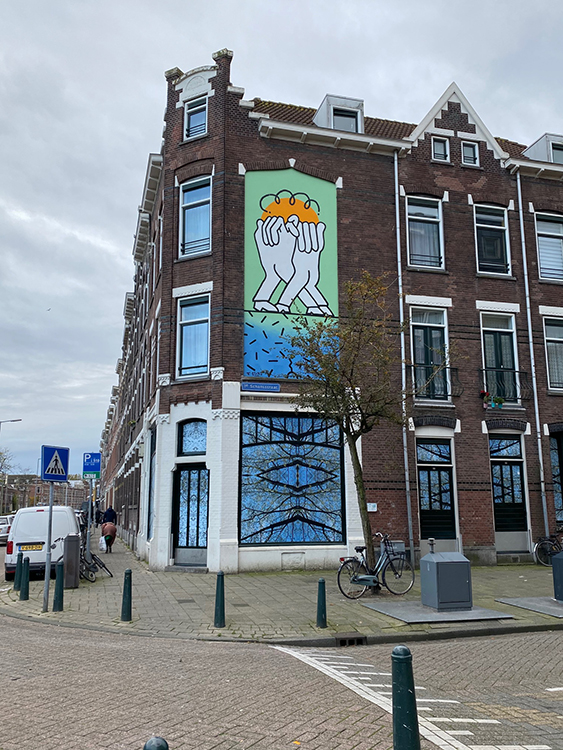Graffiti & street art in Rotterdam, from the past to the present
One of the best places in the Netherlands to spot street art and graffiti is Rotterdam. Where Heerlen claims to be the 'mural capital' of the Netherlands, Amsterdam takes care of the necessary 'street art and graffiti fix' and Utrecht is a large open-air museum, Rotterdam is working hard to unite all these qualities and maybe even surpass it.
The contemporary street scene of Rotterdam is remarkably varied and colourful. With dozens of municipal murals (murals) and many examples of illegal graffiti that compete for attention, especially along the railway, the metro tunnels and the highway. Read in this blog article more about the history of graffiti and street art in Rotterdam.
Rotterdam is a public museum that you don't have to pay for. The collection consists of a strong tradition of cross-border free street art and street art murals of an international level.
A piece of Rotterdam street art history
The first examples of street art and graffiti that manifested themselves in Rotterdam's streets came in the 70s from the punk movement. This scene mainly centered around the punk band 'Rondos', founded by a group of students from the Academy of Fine Arts Rotterdam. They rejected traditional techniques such as drawing, etching and painting and replaced them with slogans painted on the walls of the city.
In addition, they used homemade stencils in the shape of a rat, a tank or a hammer with a sickle, neatly cut from cardboard and sprayed on the walls. They were small and restrained, but present in large numbers on the streets, and the precision of the technique made it look somewhat official and dignified. A little later, the rat even got its own comic – 'Red Rat', the nickname of the artist and singer of the punk band.
That the rat is a popular animal to depict in street art and graffiti culture (think Dr. Rat, Blek le Rat, Banksy and even Mikki Waus) is of course no coincidence: apart from the fact that the rat was a popular pet in the punk scene, the animal symbolizes the street and everyone who feels rejected by society. And to quote Banksy, "A rat exists without permission."

Red rat
The Chilean (painter) brigade
In the same period in Rotterdam the 'Chilean column' established for refugees of the Chilean junta (military dictatorship). The 10-metre-high structure stood on the square near the entrance of Central Station from 1975 to 1984/85, and functioned as a 'communication column'. Large colorful paintings and committed texts such as 'Junta gone' and 'Chili free' adorned the surface and attracted the attention of the passer-by.
Artist Jorge 'Kata' Nuñez also fled the regime. In 1979 he founded a painting brigade who made politically committed murals all over the Netherlands: 'We communicated with our art, it was an ideal outlet'. Most of the brigade's work has since disappeared and the column was also removed by the municipality around 1990.
Fortunately, there are still murals of Kata Nuñez on display in the city. In the Zwartepaardenstraat in the Cool district you can admire the painting 'El Trotamundos' (the world traveler) from 2007. And if you look closely and are aware of the art-historical background, you will see that the mural refers back to the paintings on the famous Chilean column. In 2018, Kata, who returned to his home country in 2012, restored the mural during a visit to Rotterdam, making the work look like new again.
- Jorge Kata Nuñez @ccartlover
- The Chilean column in Rotterdam
80s – the start of graffiti culture in Europe
In the early 80s, graffiti also appeared in the city from a completely different angle. Through the emerging hip hop culture Rotterdam became acquainted with a different form of outdoor art. Remarkably, the new impulse from this direction was carried not only by the underground, but also almost immediately by the establishment.
For example, in 1982 the municipality of Rotterdam itself brought in the graffiti artist 'LEE' (Lee George Quinones) to Rotterdam to make a painting on the Lijnbaan as part of Townpainting (a program that was established in 1974 by the Rotterdam Art Foundation to beautify the city). At the same time, Museum Boijmans van Beuningen also bought works by Jean Michel Basquiat, Seen and Dondi, and Gallery Black Cat already showed work by Keith Haring.
The 'Piece of Lee' is now even seen as the first public expression of hip-hop and graffiti culture in Europe. In addition to this piece, Lee is with graffiti known for his role in the now legendary film 'Wild Style' in which he plays one of the leading roles alongside Lady Pink.
The early works of the Americans in the Netherlands are interesting for history, but what about the local artists? For example, who in Rotterdam belong to the graffiti writers from the very beginning and how has the scene developed further after the 80s?
- The Piece by Lee on the Lijnbaan
- Jean-Michel Basquiat, Boijmans van Beuningen collection
The transformation from graffiti to street art
Rotterdam has therefore been involved in traditional graffiti from the very beginning, and many handstyle artists are still active to this day. CES53 is such a writer from the very beginning. His gigantic oeuvre consists largely of Rotterdam work, but this artist has also made a name for himself internationally. He was one of the first graffiti artists who painted trains in the Netherlands, Belgium and Germany.
As a little boy, he was inspired by what he saw on American television channels. When he finally ended up in Rotterdam and saw the examples from the punk scene on the walls, it was a small step for him to pick up the felt-tip pen and join in. After seeing the documentary Style Wars he adapted his sizes and materials and started spraying larger work. Work that can be admired to this day.
- Ces53 – 2009
- CES53 @ccartlover
Another writer who was there early in Rotterdam is TIME. While some immortalize their 'legacy' in a tangible book, TIME (Bad Boyz Inc.) is like graffiti sprayer entered the proverbial books from the first hour. And he never stopped.
If the essence of graffiti is the demarcation of territory, TIME has succeeded in doing so in Rotterdam to the fullest: not only is it ubiquitous, but it has been so continuously since the beginning. He thus fully embodies the drive and mindset of graffiti culture.
Until recently you could read his name from the now demolished Correct building. This beautiful building had been empty for years and showed a nice collection of styles and skills by various graffiti and street art artists from the Rotterdam scene.
The number of internationally recognized 'names' from Rotterdam is considerable. Street art artists such as Bier en Brood, Telmo Miel, Nina Valkhoff, Tymon de Laat, Ox-Alien, the aforementioned Ces53, Edo Rath, Daan Botlek, Mr. June, Said Kinos, Danny Rumbl and Eelco van de Berg enjoy great national and international recognition.
A key figure in the Rotterdam scene is Rotterdam graffiti010, started writing in 1989 in the tram tunnels of Rotterdam South. He still 'paints', but nowadays he mainly makes himself heard as a collector of work from (local) street art and graffiti artists in Rotterdam on Instagram.
He recently played a role during the BEST KEPT SECRET graffiti jam at the demolition building next to Rotterdam South train station. That building, at Rosestraat 1001, looks like a remnant of a forgotten time, taken over by a storm of artists anonymous to outsiders, just as the participants in the jam wanted it.
- Best kept secret Rotterdam 2021 @ccartlover
- Correct building @ccartlover
Street art agencies and art platforms
The city is also not short of project bureaus, street art-related organizations and art platforms. For example, think of the platform for contemporary art Opperclaes, the CBK, Maison Savant and HipHop In Je Smoel. The latter organization deals with Writers hard for the Rotterdam street art and graffiti scene and also organizes the annual street art festival POW! WOW! Rotterdam. Every year the city is bursting with new street art, from cheerful and colorful to bold and challenging.
many street art murals are located in less privileged parts of the city, on the gable ends of terraced houses such as the 2021 'Wolf is sheep's clothing' by Nils Westergard (Nilsvra) op Zuid. Or on walls that are temporarily exposed due to demolition work, such as the painting by Telmo Miel and Sebas Velasco from 2017 in Hartenruststraat. This gigantic mural will soon no longer be visible due to the urban development in the Oude Noorden.
- Nina Valkhoff @ccartlover
- I am Eelco @ccartlover
- Nilsvra @ccartlover
- Ox-Alien @ccartlover
- Franky Sticks @ccartlover
- Telmo Miel, Sebas Velasco @ccartlover
Also in the newly to be developed M4H area, street art in Rotterdam used as a 'neighborhood improver'. During the first POW! WOW! in 2018, various buildings and storage sheds from the old, dilapidated port area were provided with art. You can still see the enormous murals from that time, including the collab between artists Dopie.dsk and its.Narda on the harbor quay of Marconistraat. The gigantic fish blend in nicely with the environment and come in the signature bold Dopie color palette.
The fact that street art and murals are used to give a neighborhood or district a cultural boost is nothing new. This form of city marketing has been successfully applied worldwide in recent years. Using street art as a neighborhood improver can be done in many ways, for example by turning transformer houses and electrical boxes into art objects. Read more about the possibilities of street art on transformer houses.

Dopie & Narda @ccartlover
During the 2021 edition of POW! WOW! Rotterdam Rotterdam's purveyor of extraterrestrial art, Ox-Alien, has created his largest solo work to date. This time not in its signature pink, in view of the natural colors of the environment. The fact that his work does not always have to be large to catch the eye can be seen in many places in the city. In the Oude Noorden he left several works on wooden panelling, including a few simply executed silly eyes on the Bergweg.
That is how Ox-Alien initially started, when he still worked at home under the name P. Bloem on wooden panels, which he then nailed to various places in the city. Ox-Alien is part of the 2001 founded Lastplak-collective, a diverse group of street art artists, writers and designers. The collaboration between these personalities, each with their own style and characters, results time and again in a lively 'gang' of colour, visual craziness with a good dose of humor in perspective.

Last slice on Correct building @ccartlover
Street art 2.0 – digitization
In Rotterdam you will come across all forms of street art, and since the beginning of 2021 also a digital form. A good example of how street art continues to develop are the animations, videos and illustrations that were shown during the HIJSLights project on the walls of the Santos warehouse and on the Paul Krugerstraat.
The multidisciplinary works – including those by the young audiovisual artist Wes Broersen and by graphic designer Mister Adam (Adam Oostenbrink) in collaboration with Jurriaan Hos – were visible through projections and screens for several hours from early twilight as a modern form of Rotterdam street art.
In Adam and Hos' motion graphics, the text 'yeah' spun around like a 'pin', but still remained legible because of the design and the letters – a play with form and text. With Wes it is all about a combination of moving images and sound, in which it is special that he takes care of the design as well as the software and audio part.
Street Art in Rotterdam, the conclusion…
In the current street scene of Rotterdam, the regulated form of street art plenty present. Artists from the Netherlands and abroad give new and deprived neighborhoods to be developed the desired impulse to develop further with color and figuration. The idea behind it is that these murals and murals make the neighborhood (temporarily) more lively and provide connections between residents, generations and cultures.
In addition, there is the organically created art. This movement does not require permission and revolves entirely around the autonomous expression of the artist. She sees the walls of the city not as municipal property, but as a canvas for everyone. The writers work anonymously, quickly, strictly, outside office hours and will never conform to the tolerance areas designated by the municipality.
You could say that Rotterdam is a street art museum for which you do not have to pay. The collection: a powerful tradition of cross-border free street art, colorful street art murals and municipal policy.
If you visit Rotterdam, there is a good chance that you will also come across street art in a shop, restaurant, cafe, club or hotel. More and more catering establishments are discovering the power of street art and how this can contribute to the atmosphere, experience and character of the location. Read more about street art in the catering industry such as in restaurants, clubs, hotels and shops.
Not yet finished reading about street art? Check out this one too blog messages: The murals of Heerlen as a large open-air museum, The origin of graffiti in Amsterdam of Street art in the neighborhoods of Utrecht.
Would you like to know more about graffiti and street art?
Do you have questions, comments or suggestions about graffiti and street art in Rotterdam? Or do you want to know more about the history, book a street art tour or have a street art mural made in commission? Please contact one of our specialists and receive more information or a quote without obligation.

















